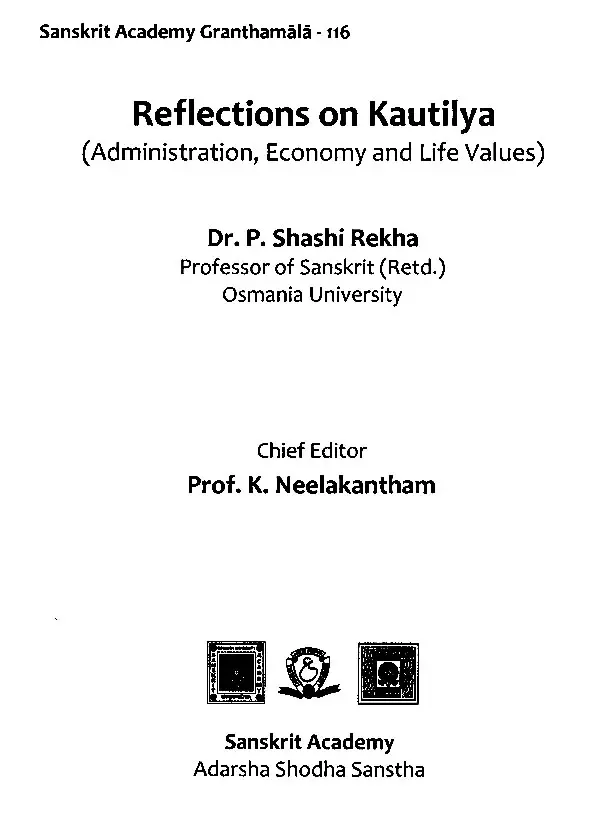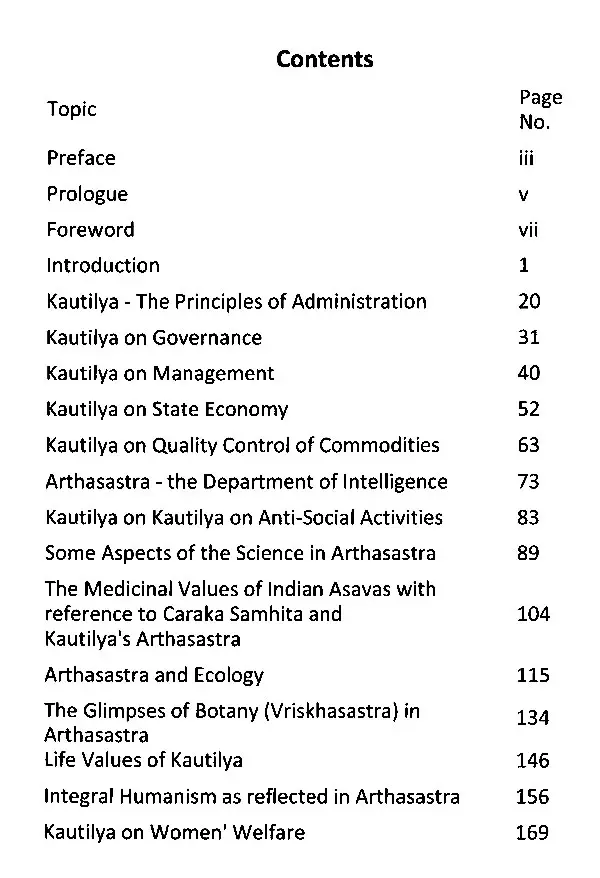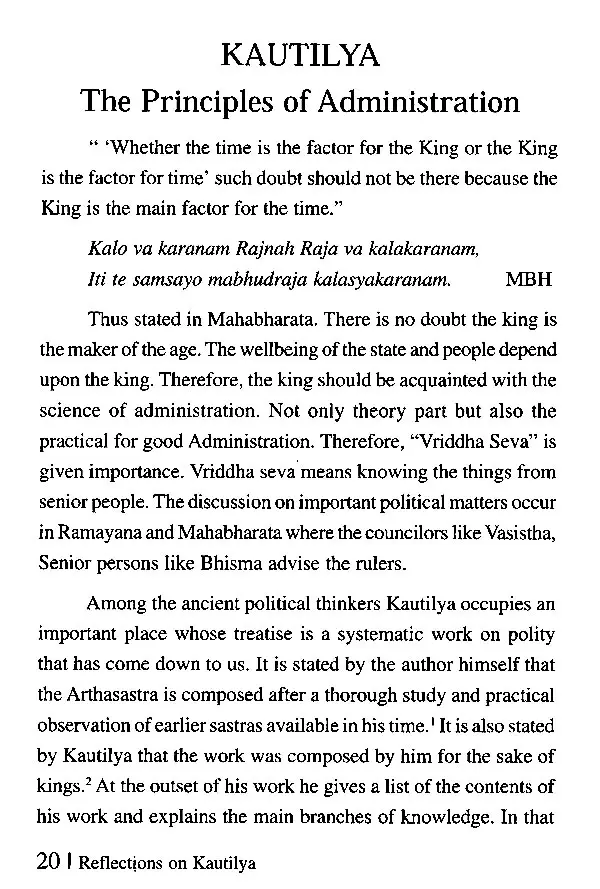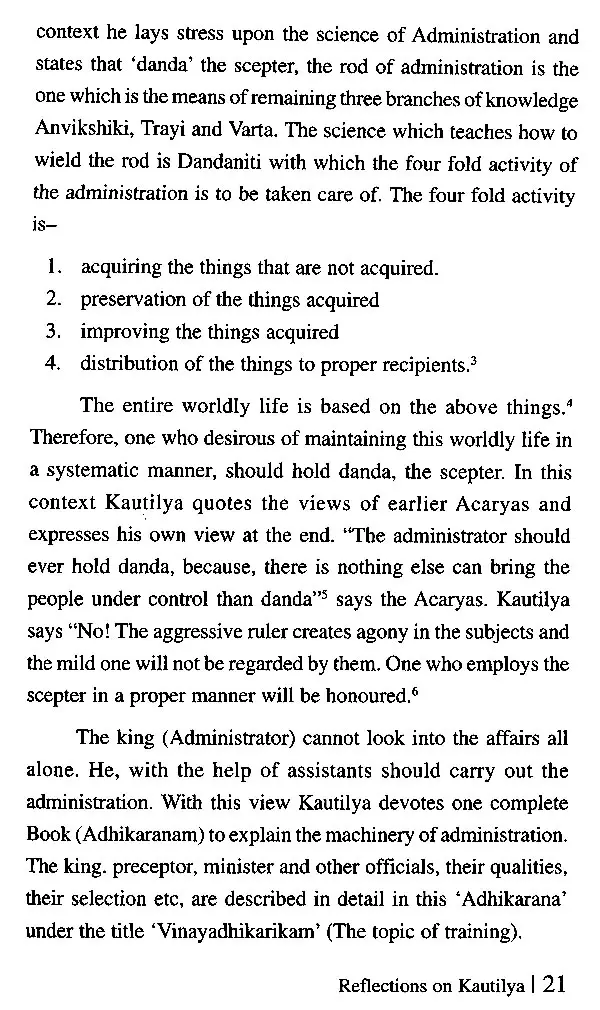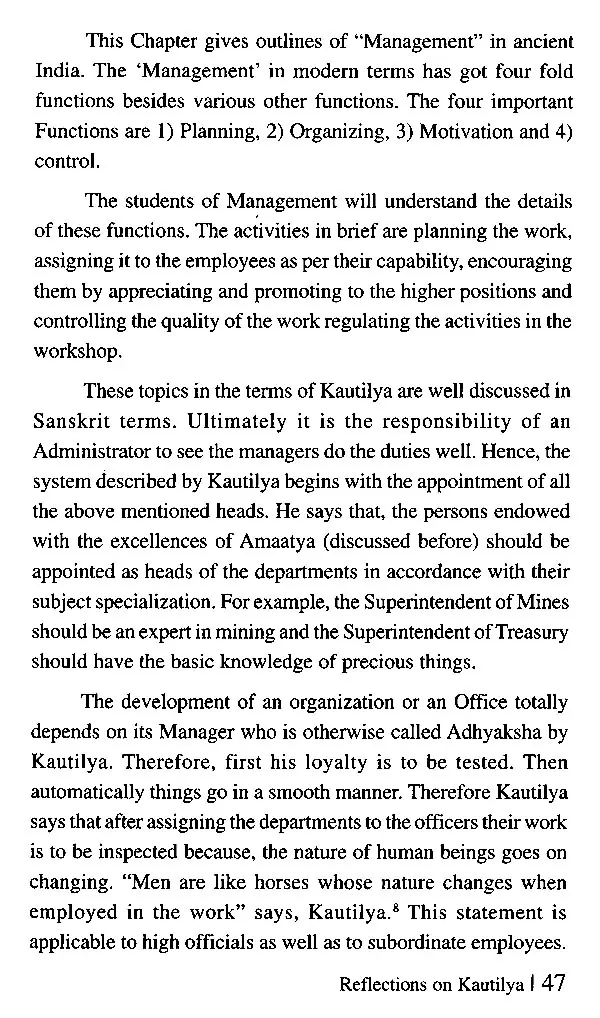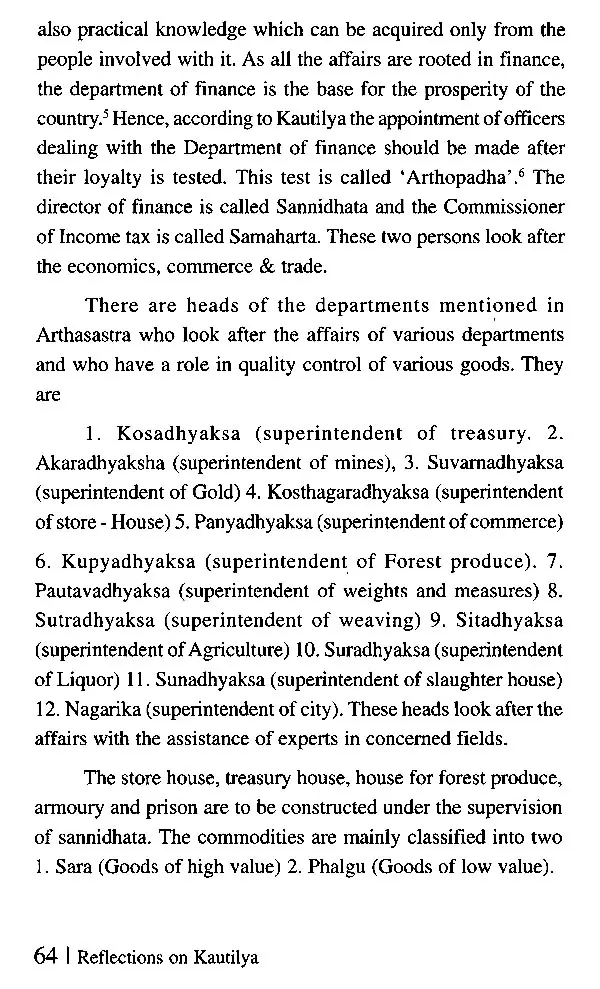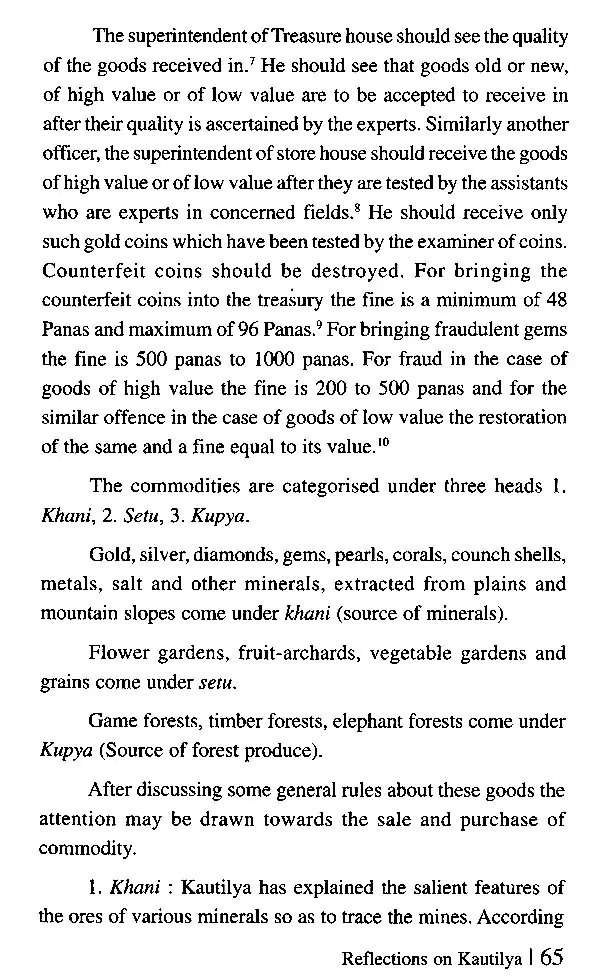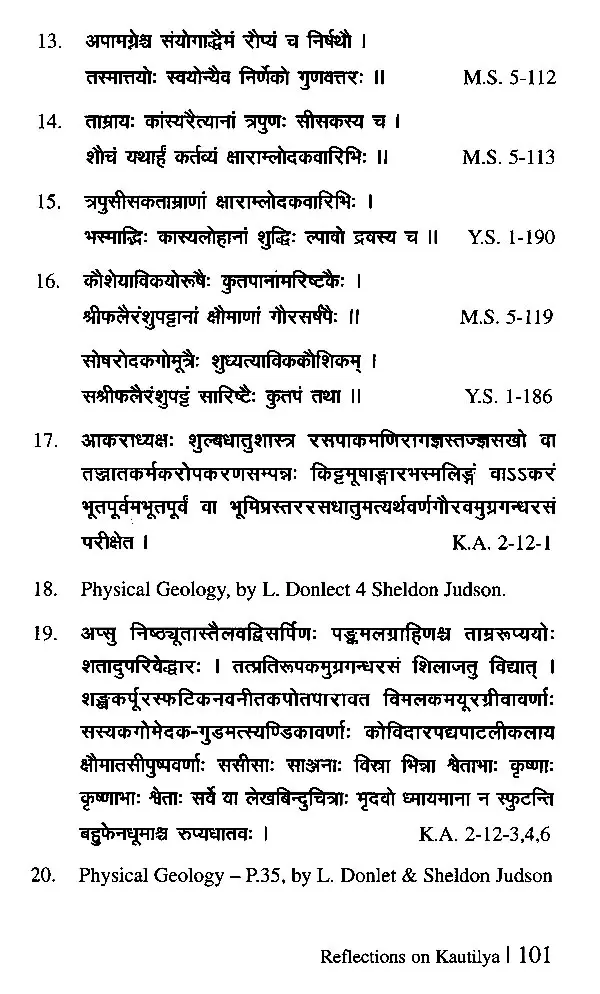
Reflections on Kautilya (Administration, Economy and Life Values)
Book Specification
| Item Code: | UAH733 |
| Author: | P. Shashi Rekha & K. Neelakantham |
| Publisher: | Sanskrit Academy, Osmania University |
| Language: | English & Sanskrit |
| Edition: | 2021 |
| ISBN: | 9789380171609 |
| Pages: | 189 |
| Cover: | PAPERBACK |
| Other Details | 8.50 X 5.50 inch |
| Weight | 240 gm |
Book Description
P. Shashirekha - Professor (Retired) from Osmania University, Telangana, is a student of Osmania University. She has pursued her studies M.A., M.Phil and Ph.D. under the noble guidance of Dr. P. Sriramachandrudu, a versatile scholar of Sanskrit. Though her field of specialization is Kautilya's Arthasastra and Smrities, she got acquainted with Alamkara and Vedantasastras by studying under her guru Mahamahopadhyaya P. Sriramachandrudu. She has authored ten books (English and Telugu) on Administration, Law, Vedanta / Sankhya/Alamnkaras and Literature. She has received an Award Ramakrishna Sanskrit Award 2000 by the Canadian Foundation. She has served the department as Head of the department and also as the Chairman, Board of Studies in Sanskrit.
Arthashastra of Kautilya presents an insight into the ancient Indian anthology of political wisdom, theory and the art of Statecraft. It is indeed one of the major political and strategic expositions which provide collection of timeless concepts. The importance and relevance of such strategies and concepts could be enriching to the contemporary world. In brief the Arthashastra is primarily a treatise on the governance of a state. It deals largely with all the important issues along with internal administration and foreign relations. Arthashastra deals with three distinct parts. The first one explores the administration. It defines the organization of the state and prescribes the duties and responsibilities of all administrators. The second part explains the code of law and justice. It deals with both civil and criminal law and provides penal code. The third one deals with the foreign policies. These three parts correspond to the three very important objectivities of a state i.e. wealth, justice and growth. "A stable and prosperous state can only be secure if it has efficient administration"
Prof. P. Shashirekha former Head Department of Sanskrit Osmania University a very distinguished scholar of Darshanas, Sahitya and Arthashastra has written books on Ancient Indian Administration, Kautilyan penal code, Technical words in Ancient Indian Polity etc. She has given more than fifty lectures on various topics of Arthashastra such as administration, economy and life values etc. which are relevant to the modern times. She has selected some of the important articles among them added more required information and made ready a book with the title "Reflections on Kautilya" (Administration, Economy and Life values). It is indeed an exceptional work and could be much beneficial to the researchers and also to the readers of Arthashasta. On seeing this excellent work, I have requested her to allow us to publish it from Sanskrit Academy. Prof. Shashirekha is my senior in the department and learnt shastras under Mahamahopadhyaya Pullela Sriramachandrudu. She is a person of very generous, kind hearted and has great regards for Sanskrit Academy hence she has accepted immediately my request. I am greatly indebted to her.
I always think amicably the support and sincere help of my two deputy directors Dr. V. Subrahmanyam and Dr. K. Varalakshmi, the two research assistants Sri K. V. Suryaprakash and Dr. Joshi Santoshkumar.
I must record my sincere thanks to Prof. Subbarayudu honorable Vice Chancellor and Prof. Subrahmanya Sharma Registrar of Central Sanskrit University, New Delhi who motivate us in the field of research and propagation of Sanskrit. And I am grateful to Prof. D. Ravinder, honorable V. C. and Chairman Management committee of Academy and Prof. Lakshminarayana Registrar of Osmania University for their encouragement.
I thank Sri K. Nagaraju, Dharani graphics, Ramnagar Hyderabad who has done D.T.P. work and Karshak Art Printers Vidyanagar, Hyderabad for printing this book on time.
It was 1981 stepped into the room of Mahamahopadhyaya Prof. P. Sriramachandrudu to request him to suggest a topic for my M.Phil Research. He has suggested me the interesting topic "Offences and Punishments in Kautilya's Arthasastra". Prof. P.G. Lalye was my guide. But he advised me to take the guidance from Prof. P. Sriramachandrudu, who was an alround and profound scholar. It is not that easy to understand the technical words of Acharya Kautilya. In each and every step Acharya Sriramachandrudu garu guided me and enabled me to submit my dissertation with in the stipulated time. The study of Arthasastra was so interesting that I felt to do further research also on the same treatise of Kautilya. After receiving M.Phil degree again I went to Acharya Sriramachandrudu garu for the topic for my Ph.D. based on Arthasastra. This time professor has taken time two to three. days and then suggested me the topic "Ancient Indian Administration with special reference to Arthasastra, Manu and Yajnavalkya".
Again, under his guidance I have completed my work and received the Ph.D. award in 1989. The grace and greatness of guru takes the students to higher goals. Within a period of six months of my Ph.D. award the Cosmo Publications approached to publish it and published in 1996. My M.Phil work also published in 2000 with the title "Kautilyan Penal Code". Thus, my two-research works are well received. Since then, I am invited by various universities (Sanskrit Departments) to give lectures on the topics related to Kautilya's Arthasastra. Thus, more than fifty lectures and papers in the seminars were presented by me during my service of 27 years in Osmania University. Most of the papers are published in Sanskrit journals and Seminar proceedings but are not known to the scholars of other faculties except Sanskrit. The subject matter discussed in Arthasastra is quite relevant to the modern times. But unfortunately, it could not find place in modern curriculum. Only a few lines found mentioned in the topics on Ancient Polity / Economics etc. This made me to take an initiative to select some of the articles to throw the light on the treasure-trove of ancient wisdom. Thus, fifteen articles are selected by me to bring into a book form. My learned friend Prof. Shashiprabha Kumar at my request has suggested the title "Reflections on Kautilya" to this book and also blessed me with her short and sweet prologue to this work. I express my heartfelt gratitude to her for extending her support throughout my academic journey.
I hope this book works like a torch to focus on the valuable gems of knowledge with which the enthusiastic researches would contribute their best to the society.
I express my gratitude to the Universities, Departments of Sanskrit and other scholars, who have provided me the opportunity to express my views in the scholarly assemblies.
I thank Prof. K. Neelakantham, Director of Sanskrit Aademy and its staff members for accepting to publish it from Sanskrit Academy.
The very mention of the name "Acharya Kautilya" creates vibrations in Indian history. The philosophy of Indian scholars is not to bother about the time, place, race they belong to. They never had interest to declare their identity because of which they have not left any clues about their history. Their main and sole aim was social welfare. One should keep in the mind that such lack of the details of their personal life infact make them as 'Sarvajanina' belonging to all.
Thus even in the case of Acharya Kautilya very little is known through literary evidences. The Vishnupurana states-
"Mahapadma Then his sons, only nine in number, will be the Lords of the earth for a hundred years. Kautilya, a Brahmin will slay them. On their death the Mauryas will enjoy the earth. Kautilya will install Chandragupta on the throne. His son will be Bindusara and his son will be Ashokavardhana (King Ashoka)". Ashokan inscriptions also stand as evidences to some extant in deciding the period of Chandragupta and Kautilya.
According to Indian epigraphical researches Chandragupta was made king in 321B.C., and Ashokavardhana ascended throne in 296B.C. Therefore, it may be during this period that Acharya Kautilya has composed his magnumopus "Arthasastra'.
Kamandaka, who has modeled his Nitisara on 'Arthasastra' pays tributes to Acharya Kautilya and appreciates his genius with which he single handedly over threw Nanda Dynasty. He says -
"Salutation to the great Vishnugupta, who is a Brahma (in intellect), by whose fuming luster like thunderbolt with which the rich Nanda mountain fell down along with its roots, who alone with his powerful diplomacy like Indra with his thunderbolt, bestowed the earth on Chandragupta, the moon among men and who broughtout the nectar of polity by churning the ocean of political science.
Coming to the name of Acharya Kautilya there are different explanations by the scholars. According to some he is Kautilya because, he belongs to 'Kutala' gotram, known as *Chanakya hailing from 'Chanaka'. As mentioned above, Vishnupurana refers to Acharya Kautilya by the name Kautilya and Kamandaka by the name Vishnugupta. Acharya Kautilya mentions "Kautilya' throughout the work and only at the end mentions as Vishnugupta, where he clarifies that both the Sutra and Bhashya are composed by the same author Vishnugupta. He states -
"Having seen the discrepancies in many ways on the part of the writers of commentaries on the Sastras, Vishnugupta himself has made Sutra and Bhashya (commentary)". He also claims that this work is composed by him who has angrily seized the weapon (Sastra), the science (Sastra) and the territory gone in to the hands of Nanda Kings.
Thus Acharya Kautilya is very meticulous and has not given any scope even a little to corrupt the main text. To know the genius of Kautilya no evidences are required. The text "Arthasastra" stands as a model to a research work. All the sastric formulas are adopted in the arrangement.
Coming to the arrangement of the text, there are 15 Adhikaranas, 150 Adhyayas and 180 Prakaranas in which the subject matter is divided. The first chapter of 1" Adhikarana enlists the topics discussed in the text. At the outset the author states that the present work is composed after going through almost all the Arthasastras composed by ancient teachers dealing with the subject of acquisition and maintenance of the earth.
Thus the purpose of the work is also indicated through the above statement. Kautilya had a perfect vision which reflects through Arthasastra which explains even a minor topic pertaining to the welfare of the people. According to him a country means not the mere land but that which has the resources that provide livelihood to the inhabitants. It is defined by him in the following words.
"The Artha (cash or kind) is the sustenance of the human beings, it is the earth which has people inhabited in it, the science which is the means of acquisition and protection of such earth (country) is Arthasastra".
This statement is the base for the entire polity. The two things which are mentioned here are proved by the history.. The first one - acquisition of the kingdom. The example may be taken from the great epic Mahabharata. When Pandavas were sent out of Hastinapura, they with the help of Lord Srikrishna have constructed Indraprastha by developing the dreadful forest Khandava. Similarly many kings either conquered others' kingdoms or made establishments with the cooperation of their followers. The second one is protection of the state acquired. As soon as a king occupies the throne he would try to suppress the enemies and would take the welfare schemes for the kingdom.
